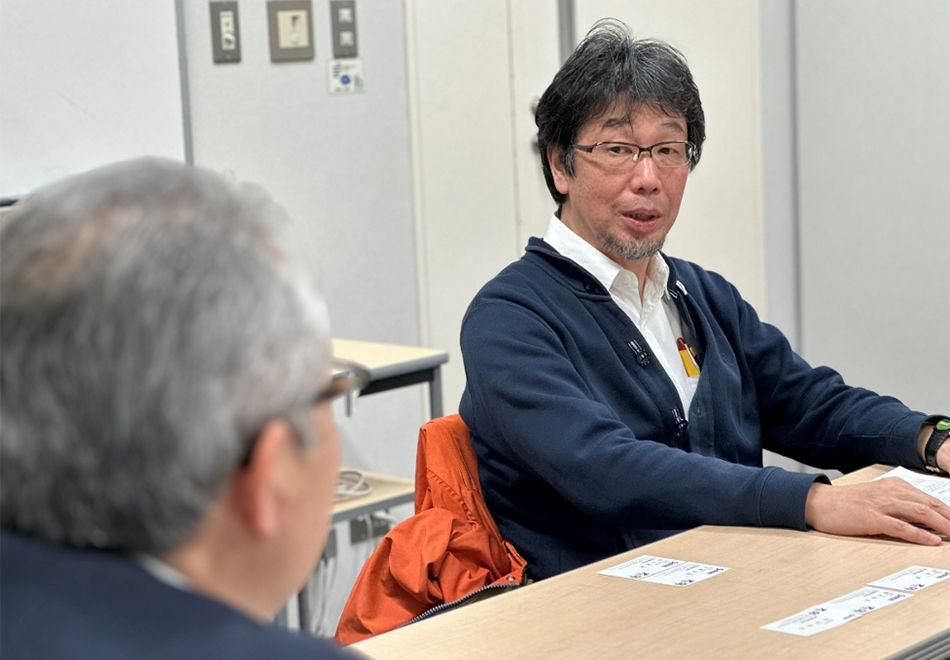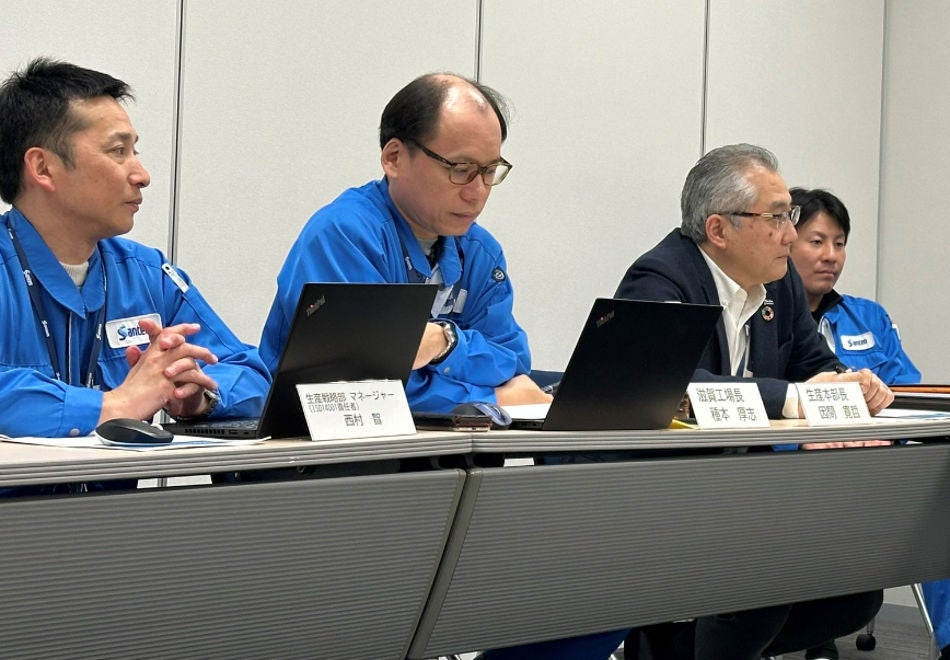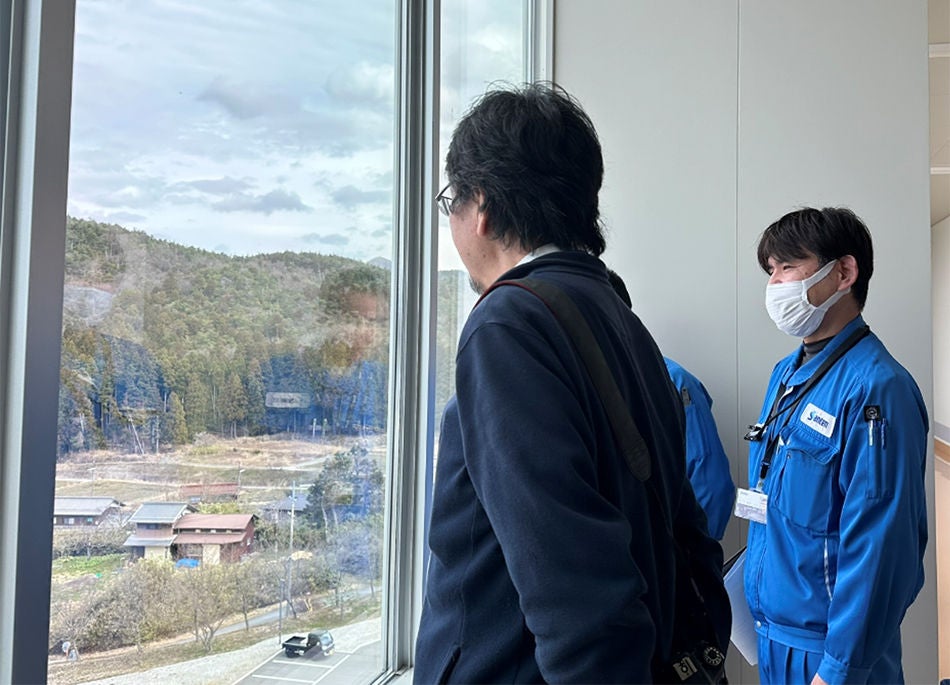Biodiversity is one of the most important issues we face as a company. In March 2024, we invited Dr. Shin-ichi Meguro, Senior Researcher at the Japanese Center for International Studies in Ecology of the Institute for Global Environmental Strategies, to engage in a dialogue on the conservation of natural capital and biodiversity with senior management in our Manufacturing and Sustainability Division s. The dialogue centered on what we can do specifically through our business activities to address this important issue.
- Dr. Shin-ichi Meguro:Senior Researcher, Institute for Global Environmental Strategies, Japanese Center for International Studies in Ecology
- Hironori Imma:Head of Manufacturing Division
- Atsushi Tanemoto:Plant manager, Shiga Plant, Manufacturing Division
- Satoshi Nishimura:Manager, Manufacturing Strategy Department, Manufacturing Division (Environmental management representative)
- Takahiro Morita:Corporate Officer, Global Head of Core Principle & Sustainability
- Kaori Itagaki:Senior Director, Head of Sustainability (Moderator)
(*Titles are as of the time of the dialogue)


The Relationship Between the Forests and the Water Resources Vital to Santen
(Moderator)
Our new Sustainability Commitment states clearly that water is a particularly important natural capital for Santen as an eye drop manufacturer. From the perspective of biodiversity, what is most important for Santen in conserving water resources?
Nishimura: The source of water for the Shiga Product Supply Center is Lake Biwa, a very important lake. We engage in several initiatives to prevent environmental change. Our efforts include reducing the environmental impact of our plants, which we believe helps protect rare species living in and around Lake Biwa.
Morita: Lake Biwa a is very important presence. Our Noto Plant uses well water, as many may know. Water is one of our most important natural capitals, even though we may not have as much impact on or restrictions related to water use compared to other manufacturers. What do you see as the relevant issues?
Imma: We recognize that we use many times more volume of water than in our products themselves. In other words, we use water as other than a raw material, too. Most of the water used in our manufacturing process is for cooling and cleaning. This is why we focus on using water effectively in these processes. At the same time, the well used by the Noto Plant has dried up on occasion. Without rain, even Lake Biwa can experience water stagnation. My question is about the relationship between forests and the preservation of bodies of water.
Dr. Meguro: Even in Japan, which is blessed with abundant precipitation, we see many examples of major flood damage due to the loss of forest function. Water can dry up or, conversely, cause heavy flooding. The scale of damage is greater than ever before, as seen in the flooding of Kansai Airport during Typhoon No. 21 in 2018 and the flooding of shinkansen bullet trains during Typhoon No. 19 in 2019. The Japanese people are blessed with a favorable environment and tend to take water for granted. It's very important for Santen to explore issues from the perspective of the appreciation for water and the company's business.
Biodiversity is About Quality, Rather Than Numbers
(Moderator)
What challenges do you see in terms of biodiversity for the areas in the vicinity of our manufacturing plants in Japan?
Tanemoto: The Shiga Product Supply Center is located in an industrial park that was carved out of a mountain. Sometimes, on my way to work, I think about how much of an impact the construction has had on the environment. Deer and boars cross the road regularly, often being hit by cars. This fact reminds me of the significant impact we have on their ecosystems. Over the long history of life and plants on the Earth, we have seen a repeated cycle of extinctions and new species. What changes have you noticed over the past 50 years or so?
Dr. Meguro: I think you make a very important point. In terms of wildlife, the eradication of wolves has resulted in the disappearance of predators. At the same time, global warming is contributing to an increase in the deer population. Deer are becoming emaciated due to a lack of food. We have an abundance of cedar trees, but these trees don't bear fruit for animals to eat. The soil deteriorates and produces no flora. As these forest creatures lose their habitat, they migrate further and are run over by cars.
Before we talk about global warming, I want to say that nature, in the strictest sense, is only about 0.1% of what was originally in Japan. You might think that Africa is where one might find original nature, but the fact is that very little remains. In general, humanity has already intervened. That is the incredible scale of human impact, and this impact has only accelerated over the past 50 years. It is unfortunate to see land formerly protected from use for habitation now developed into residential areas, and how people disregard their responsibilities in the pursuit of money. In the past, we looked at nature with a sense of awe. Today, people have lost touch with nature, feeling quite separate.
Meanwhile, our definition of biodiversity does not refer to species of organisms in terms of mere numbers. We define biodiversity as a state of well-balanced ecosystems supported by the interaction of the diverse characteristics of each organism. In other words, the quality of the ecosystem. The best way to maintain a healthy ecosystem is to have living organisms native to the land in question. This is the way to protect living organisms by leveraging the potential of the resources and topography originally present in the area. And in fact, this way is less costly to manage and allows for longer-lasting initiatives on the part of companies.

Imma: Mt. Ibuki is near the Shiga Product Supply Center and is famous for its heavy snowfall. People have collected medical herbs in the area from ancient times. It's even said that the Portuguese created medicinal herb gardens during the 16th century. My understanding is that these medicinal herbs are dying out due to global warming and other developments. The famous Chirihama Nagisa Driveway lies along the coast near our Noto Plant. But the coast continues to erode with each passing year, presenting a difficult issue for the surrounding community.
Tanemoto: The problem is that we don't really understand the cause of the erosion. Some say the cause is the rising sea level due to melting polar ice. Other theories include the dam being built in Ishikawa Prefecture. But if we don't understand the cause, we can't come up with a solution.
Dr. Meguro: These problems are typical throughout Japan. Not only are the beaches disappearing rapidly, but the fish and seaweed in the surrounding waters are also disappearing. I have been approached by my hometown of Hayama to help devise response measures. Even if the precise cause is not clear, there is no doubt that human influence is involved. Sand is normally supplied by the river currents, but is blocked by the dam. River floods happen several times a year, and the plants along the riverbed that had adapted to the conditions begin to disappear in greater numbers. The beach issue is a very big problem. Planting seaweed could be an answer, but fishing rights issues becomes a problem. And even planting seaweed won't guarantee that the vegetation will last for any amount of time. The end result is no more fish. In an ecological pyramid, the plants and seaweed at the bottom must be ten times greater than the organisms above. But humans are destroying this entire base. Losing the nature under us is, in essence, like eating one's own feet. Japan has a high capacity for natural regeneration. No other place in the world exists where the soil is so good. But I fear the damage has become irreversible in recent years. It may take time, but the first order of business is to take care of one's own hometown. Otherwise, we will surely see more disasters caused by natural destruction and more situations where human lives are at stake.
Begin by Getting in Touch With Nature
(Moderator)
You mentioned the potential for more situations where lives will be at stake. From the standpoint of risk management as well, it will be important to preserve the natural environment around us. Where should we start?
Imma: Since I work in a location surrounded by trees and mountains, I suppose the best way forward would be to restore the forest. But I think everyone wonders what the exact issues are and where we should focus.
Dr. Meguro: I think we should start by understanding even a little about what we have done to the environment and that we have a responsibility to put things right. First of all, we can make time to interact with nature mindfully, going to a forest and taking just five minutes to touch the good soil. Tree planting events would also be a good idea. Even planting a few saplings together with your children or local elementary school students would be a beneficial experience. However, it is important to plant the appropriate combination of species that originally existed on the land to restore its original appearance. From these simple experiences, we can draw our own honest conclusions. Given the natural disasters, global warming, and other issues we face today, we must understand that nature is what ultimately protects our lives.
Morita: I think we learned a number of important hints. Now, it's up to us to apply what we learned and the insights from today's dialogue to our future activities.
